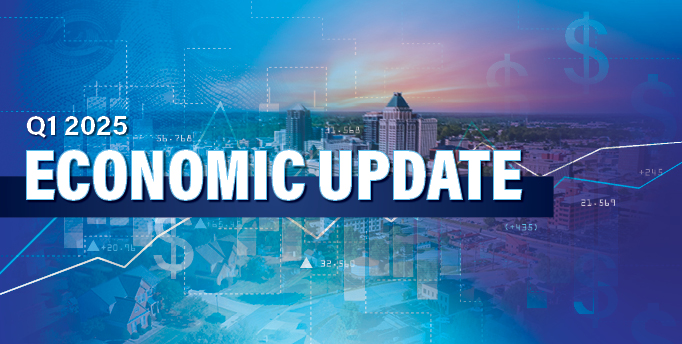Gross Domestic Product (GDP) dipped in Q1 2025 due to apprehensions over sticky inflation, the cooling employment situation and new tariff implications. The latter caused the Commercial Real Estate (CRE) markets to waver a bit. Although home buyers also faced these headwinds, rising inventory was welcomed for the upcoming prime selling season.
RESIDENTIAL REAL ESTATE
The return of the 30-year fixed rate mortgage to over 7% in January dampened activity early on and fostered quarterly performance figures that were deceptively uninspiring. According to the Mortgage Bankers Association (MBA), Single-Family Starts and Total Existing Home Sales were relatively flat this quarter compared to last quarter. New Home Sales fared better, rebounding by 4%, but were still below Q3 2024 levels.
Fortunately, later monthly indicators signaled resilience. Existing Sales, New Sales and Housing Starts in February, and March's weekly mortgage applications, all advanced on a yearly basis. A silver lining to slower economic growth was the descent in mortgage rates over the last two months by over 30 basis point—a major contributor to the market swing. Median Prices were virtually unchanged for both Total Existing Homes and New Homes in Q1 2025, enticing motivated buyers. Moreover, buyers appeared amenable to the adage "buy the house, not the rate." Refinances in Q1 2025 were, at times, double last year's volume.
As the chart below shows, mild swells in inventory also lifted the market. Active Listings grew 27.5% in February compared to last year, prompted by life events and the fading lock-in effect. According to the National Association of REALTORS® (NAR), over 35 million homeowners were mortgage-free and 9 million of those with a mortgage had an interest rate above 6% as of Q2 2024.

"Home buyers are slowly entering the market," said NAR Chief Economist Lawrence Yun. "Mortgage rates have not changed much, but more inventory and choices are releasing pent-up housing demand." Indeed, a "reality TV effect" market could reemerge; one where the buyer can view three houses and actually have one of their bids accepted. If so, a sea change for the spring market could be on the horizon.
COMMERCIAL REAL ESTATE
Transaction volume was approximately $48 billion for the four major asset groups, according to CoStar—well below Q4 2024 volume, but similar to Q1 2024 volume. Market participants digested the course changes to Gross Domestic Product (GDP) forecasts, the Federal Reserve's interest rate path and the new administration's policies. But as a consultant commented to Bisnow, "Everybody's trying to get deals done, and it hasn't hit to the point of stop." Indeed, beneficial price adjustments continued and the days on market liquidity measurement improved. CoStar's data showed that Office was the only sector with upward pressure on cap rates. Distress and delinquencies were not yet significant market movers.
The major sectors experienced demand to varying degrees, but all are facing a drop in deliveries that will boost their fundamentals. Sustained housing needs pushed Multifamily month-to-month rental growth into positive territory, with CoStar reporting that the vacancy rate peaked at 8.1% in March with absorption gains in every major market. Industrial is at the lowest point of its cycle, due to a historically large volume of inventory added in 2023.
According to JLL, Q4 2024 Industrial vacancies ticked up to 7.1% and annual rent growth fell below 1%. However, tailwinds include an upcoming new delivery space gap due to a significant decline in groundbreakings over the past years, as well as already announced manufacturing expansions and President Trump's push for additional reshoring and foreign direct investment in the U.S. Retail store closings surpassed openings in 2024 and rental growth softened to a 1.9%. But spaces backfilled quickly and vacancies were steadfast at 4.1%. New office space starts were at a historical low in March and some markets have seen intense clamoring for top space, according to CoStar. However, national vacancy sat a 13.9% and is likely to rise, especially if the federal government reduces its footprint.
A GLANCE FORWARD
Fannie Mae projects that shrinking government spending, flat business investment and cautionary personal consumption will bring a slight dip in GDP growth in Q2 2025 and a bit more unemployment. The Fed is not expected to lower its rates soon, as it is in "wait and see" mode on the inflationary impact of evolving tariffs. But it did continue its planned reversal of Quantitative Tightening, which should help boost liquidity to finance markets.
The gentle swell of activity in the residential market is expected to roll into spring, supported by an increase in housing inventory and mortgage rates around 6.8%. The MBA forecasts that Housing Starts, Existing Sales and New Sales will all pick up, while the FHFA House Price Index moves below inflation.
CRE may stay subdued or could take one of two directions. The looming development space gaps could strengthen the "early mover" mentality, with companies battling to be the first to capitalize on emerging market trends. If stagflation fears emerge, the resolution to properties "on the bubble" could hasten. Distressed properties could convert into targets for the growing pool of distress funds, while slipping 10-year treasury bond rates could help ease the financing challenges for healthier properties.
Overall, the forecast for the next three months calls for cloudy weather, but real estate markets may take advantage of the fertile ground spring rains might provide.




